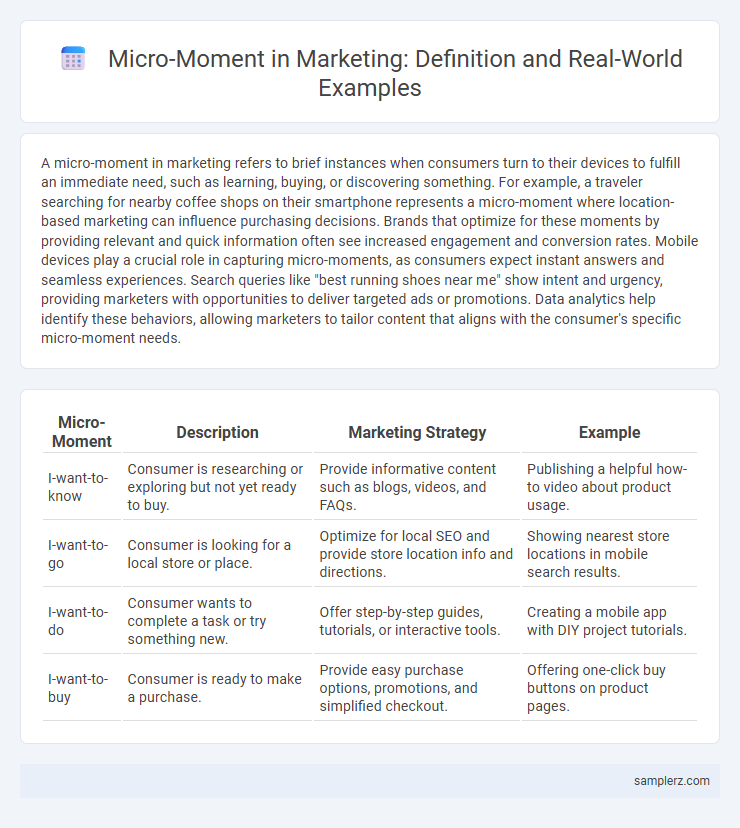A micro-moment in marketing refers to brief instances when consumers turn to their devices to fulfill an immediate need, such as learning, buying, or discovering something. For example, a traveler searching for nearby coffee shops on their smartphone represents a micro-moment where location-based marketing can influence purchasing decisions. Brands that optimize for these moments by providing relevant and quick information often see increased engagement and conversion rates. Mobile devices play a crucial role in capturing micro-moments, as consumers expect instant answers and seamless experiences. Search queries like "best running shoes near me" show intent and urgency, providing marketers with opportunities to deliver targeted ads or promotions. Data analytics help identify these behaviors, allowing marketers to tailor content that aligns with the consumer's specific micro-moment needs.
Table of Comparison
| Micro-Moment | Description | Marketing Strategy | Example |
|---|---|---|---|
| I-want-to-know | Consumer is researching or exploring but not yet ready to buy. | Provide informative content such as blogs, videos, and FAQs. | Publishing a helpful how-to video about product usage. |
| I-want-to-go | Consumer is looking for a local store or place. | Optimize for local SEO and provide store location info and directions. | Showing nearest store locations in mobile search results. |
| I-want-to-do | Consumer wants to complete a task or try something new. | Offer step-by-step guides, tutorials, or interactive tools. | Creating a mobile app with DIY project tutorials. |
| I-want-to-buy | Consumer is ready to make a purchase. | Provide easy purchase options, promotions, and simplified checkout. | Offering one-click buy buttons on product pages. |
Understanding Micro-Moments in Modern Marketing
Micro-moments in marketing occur when consumers reflexively turn to their devices to act on a need to learn, do, discover, or purchase instantly. For example, a traveler searching "best hotels near me" during a layover exemplifies a micro-moment, where real-time, location-based marketing can influence their decision. Brands optimizing content for these intent-driven interactions capture high-conversion opportunities by delivering relevant, immediate information tailored to the consumer's exact need.
Real-Life Examples of Micro-Moments in Action
A consumer searching "best running shoes near me" on their smartphone exemplifies a micro-moment driving immediate purchase decisions in sports retail marketing. Starbucks leverages micro-moments by targeting app users with personalized offers during morning commutes, increasing in-store visits. Google's "I want to learn" micro-moment campaign boosted engagement by delivering tutorial videos when users sought quick how-to content.
Types of Micro-Moments That Influence Consumer Behavior
Types of micro-moments that influence consumer behavior include "I-want-to-know" moments where users seek information, "I-want-to-go" moments involving location-based searches, and "I-want-to-buy" moments focused on purchase decisions. Brands capitalize on these moments by providing timely, relevant content and seamless mobile experiences that meet immediate consumer needs. Understanding these micro-moments enables marketers to deliver personalized messaging that drives higher engagement and conversion rates.
How Brands Leverage “I-Want-to-Know” Micro-Moments
Brands leverage "I-Want-to-Know" micro-moments by providing instant, relevant information through optimized content such as FAQs, blogs, and videos that address specific customer questions. Using targeted SEO strategies and mobile-friendly interfaces ensures visibility during these intent-rich moments when consumers actively seek knowledge. This approach increases brand authority and drives engagement by meeting user needs precisely at the research phase of the buying journey.
Enhancing Customer Experience with “I-Want-to-Go” Moments
"I-Want-to-Go" micro-moments occur when customers search for immediate, location-specific information to make quick decisions, such as finding nearby restaurants or stores. Brands enhance customer experience by providing real-time, accurate maps, directions, and availability updates, ensuring seamless navigation and convenience. Leveraging these moments boosts engagement and drives foot traffic, optimizing local marketing strategies for higher conversion rates.
Capturing Attention During “I-Want-to-Do” Micro-Moments
Brands maximize engagement by targeting "I-Want-to-Do" micro-moments when consumers seek immediate solutions or inspiration for actions like cooking, workouts, or DIY projects. Integrating how-to videos, step-by-step guides, and localized offers into mobile search results captures attention and drives conversion by fulfilling instant needs. Leveraging search intent data and contextual relevance in these moments offers marketers a strategic advantage to deliver personalized, actionable content that accelerates decision-making.
Turning “I-Want-to-Buy” Moments into Sales Opportunities
During "I-Want-to-Buy" micro-moments, consumers actively seek product information and are ready to make a purchase decision. Marketers capitalize on these instances by providing instant access to detailed product reviews, pricing comparisons, and seamless online checkout options. Optimizing mobile-friendly content and targeted ads during these micro-moments significantly boosts conversion rates and drives immediate sales.
Successful Case Studies of Micro-Moment Marketing
Successful micro-moment marketing campaigns leverage real-time consumer intent to deliver highly relevant content, as demonstrated by Domino's "AnyWare" strategy, which allowed customers to order pizza through various digital platforms effortlessly. Another key example is Nike's use of geofencing to target potential customers near their stores with personalized offers, driving immediate foot traffic and sales. These case studies highlight how brands can effectively capture intent-rich micro-moments to boost engagement and conversion rates.
Tools and Strategies for Identifying Micro-Moments
Marketers deploy advanced analytics tools like Google Analytics and heat mapping software to identify micro-moments by tracking user behavior and engagement patterns across devices and platforms. Strategies such as real-time data monitoring and AI-driven sentiment analysis enable brands to capture intent-rich moments when consumers seek immediate information or solutions. Leveraging these insights, marketers optimize content and ads to deliver contextually relevant experiences, driving higher conversion rates and customer satisfaction.
Future Trends: Evolving Role of Micro-Moments in Marketing
Micro-moments in marketing are shifting towards hyper-personalization, leveraging AI and real-time data analytics to deliver contextually relevant content during consumer decision points. Brands are integrating voice search and augmented reality to capture the "I-want-to-know" and "I-want-to-buy" micro-moments more effectively. Predictive technologies enable marketers to anticipate consumer needs before they arise, enhancing engagement and conversion rates in future marketing strategies.

example of micro-moment in marketing Infographic
 samplerz.com
samplerz.com